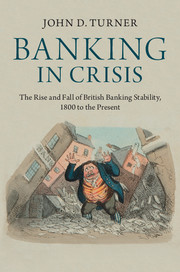Book contents
- Frontmatter
- Contents
- List of figures
- List of tables
- Acknowledgements
- 1 Introduction: Holding shareholders to account
- 2 Banking instability and risk shifting
- 3 The evolution of British banking structure and stability since 1800
- 4 Major and minor British banking crises since 1800
- 5 Banking stability, shareholder liability and bank capital
- 6 Averting or creating banking crises? The lender of last resort and bank rescues
- 7 Banking stability and bank regulation
- 8 Restoring banking stability: Policy and political economy
- Bibliography
- Index
2 - Banking instability and risk shifting
Published online by Cambridge University Press: 05 July 2014
- Frontmatter
- Contents
- List of figures
- List of tables
- Acknowledgements
- 1 Introduction: Holding shareholders to account
- 2 Banking instability and risk shifting
- 3 The evolution of British banking structure and stability since 1800
- 4 Major and minor British banking crises since 1800
- 5 Banking stability, shareholder liability and bank capital
- 6 Averting or creating banking crises? The lender of last resort and bank rescues
- 7 Banking stability and bank regulation
- 8 Restoring banking stability: Policy and political economy
- Bibliography
- Index
Summary
The history of money, banking, and financial legislation can be interpreted as a search for a structure that would eliminate instability. Experience shows that this search failed and theory indicates that the search for a permanent solution is fruitless.
H. P. MinskyPreamble
This chapter attempts to conceptualise and theorise the reasons why banking becomes unstable and why banking systems experience crises. This chapter is not about how crises should be tackled once they occur; rather, it is about why crises occur in the first instance. It is important to think conceptually about banking stability because it helps to organise and interpret the historical narrative of banking stability in the United Kindgom during the past two centuries.
The first section explains why banking instability matters by describing how banking crises can have widespread ramifications for the economy and even for political stability. The second section uses a hypothetical bank to explore the traditional reasons given in the extant literature as to why a bank might fail. It demonstrates the vulnerabilities in the nature of banks’ assets and liabilities that may make them prone to instability. The third section contends that these vulnerabilities highlighted in the extant literature are an incomplete explanation of banking instability. Consequently, this section takes a hypothetical bank and develops a theory of banking instability based on the incentive structures of bankers, shareholders and depositors. In particular, the concept of ‘risk shifting’, which is when bankers opportunistically – and unobserved by depositors – increase the risk of a bank’s asset portfolio, is highlighted.
- Type
- Chapter
- Information
- Banking in CrisisThe Rise and Fall of British Banking Stability, 1800 to the Present, pp. 15 - 34Publisher: Cambridge University PressPrint publication year: 2014



